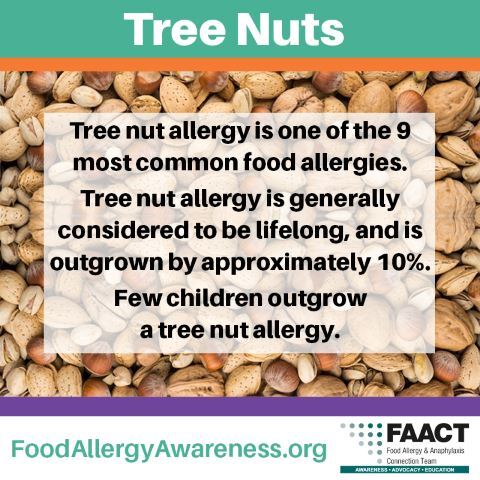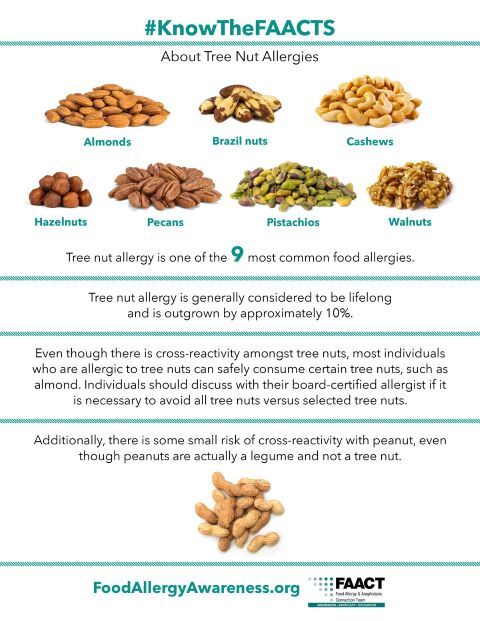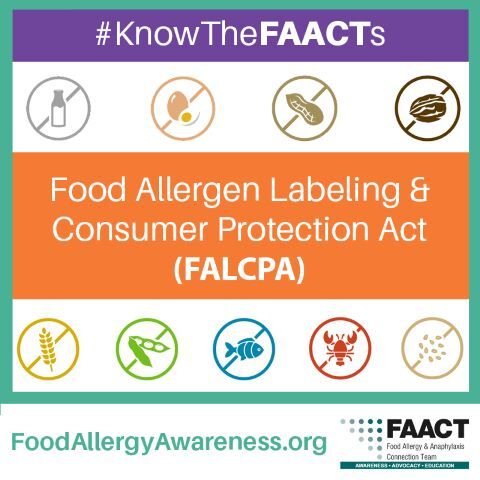Tree Nuts
Subcategories

Tree Nuts
Tree nuts are one of the 9 most common food allergens. Tree nut allergy is generally considered to be lifelong and is outgrown by approximately 10%. Tree nut allergy often have a cross-reactivity with other different types of tree nuts. Additionally, there is some small risk of cross-reactivity with peanut, even though peanuts are actually a legume and not a tree nut. It is recommended that individuals see a board-certified allergist to discuss the need to avoid peanut due to a tree nut allergy, as well as the need to avoid all tree nuts. Because tree nuts have very similar structures, allergen tests may reveal multiple positive recognitions. However, all of these recognitions may not result in an allergic reaction. Oral food challenges may be useful to rule in or rule out if these nuts are safe to consume. In some cases where the tree nut allergic individual may tolerate selected tree nuts and not others, there is concern for possible cross-contamination due to co-processing of tree nuts by manufacturers. These are all issues that should be discussed with your board-certified allergist, since no universal rule is likely to apply to all tree nut allergic patients.
Tree nut prevalence rates in the United States are approximately 1% percent. Few children outgrow a tree nut allergy. Tree nut allergies account for the majority of IgE-mediated reactions in teenager and adult reactions. Delay in administering epinephrine for anaphylactic reactions to tree nut has been associated with deaths. [1]
Practical Tips
It is recommended to always carry at least two (2) epinephrine devices at all times if you have been diagnosed with a tree nut allergy. This is in case one misfires or if symptoms return and a second dose is needed. If an epinephrine device has been used, always seek emergency medical assistance immediately. This is due to the possibility of a biphasic reaction. A biphasic reaction is when a second wave of a reaction occurs, which is usually stronger than the first. It can occur within 2-4 hours and in some cases, up to 8 hours, after the initial reaction. Stay in medical care for at least 4-6 hours. Strict avoidance of tree nut and products containing tree nuts is necessary.
Read all product labels prior to the consumption of a new food product. Before consuming any products, it is important to always read labels carefully to ensure the safety of a food product. All food products that contain tree nut protein as an ingredient are required by FALCPA law to list the word “Tree nut” on the product label.[1] According to the Food Allergen Labeling and Consumer Protection Act (FALCPA), food products with the advisory statements such as “may contain”, “might contain”, or “manufactured in a shared facility that process” on a package are completely voluntary and can be ambiguous. The true level of contamination is not declared and may range from parts per million to micrograms. There may be different risks associated with these levels. It is generally recommended to avoid products with such labeling because of this uncertainty.
Cross-contact can occur when utensils between an unsafe food has been shared with a safe food. For example, shared cooking utensils or a deli meat slicer can be contaminated from nut-containing products. Cooking utensils should be thoroughly washed with soap and water. Another example of cross-contact can occur with picking out tree nuts from a meal and serving it to a tree nut allergic individual. This may be common with salads. It is still unsafe for consumption. A new clean plate, with a safe meal, should be served to the tree nut allergic individual.
Visiting restaurants can be a pleasant experience for family and friends to gather together. However, some restaurants may pose as a risk. Certain restaurants, ice cream parlors, and bakeries are considered high risk for individuals with tree nut allergy due to the common use of nuts. Please review our 'Dining Out' page for tips on how to manage visiting a restaurant. Be vigilant, ask questions, and if there is any doubt, don’t eat the food item in question.

AVOID foods that contain tree nut ingredients, such as:
- Almond
- Brazil Nut
- Cashew
- Hazelnut/Filbert
- Pecan
- Pistachio
- Walnut
- Argan Nut
- Chestnut
- Macadamia Nut*
- Pine Nut (Pignolia Nut)*
NOTE: while pine (pignolia nut) and macadamia nuts are technically seeds, many allergists recommend avoidance of these items. Please check with your board-certified allergist for specific guidance.
Tree Nuts in Unexpected Places*
- Cereals
- Crackers
- Cookies
- Candy
- Chocolates
- Energy bars
- Flavored coffee
- Frozen desserts
- Marinades
- BBQ sauces
- Nutritional supplements
- Medications
- Cold cuts like Mortadella
- Pet foods
- Bird seeds
- Trail mixes
NOTE: Please keep in mind in a culturally diverse world, different ingredients may be used in different recipes. Always use extreme caution.
Special Considerations
Nut Extracts/Flavoring
Natural extracts such as pure almond extract and wintergreen extract (for the filbert/hazelnut allergy) should be avoided. Imitation or artificially flavored extracts are generally safe. Sometimes it is difficult to determine which is being used in the product, so please check carefully. Gianduja (a creamy mixture of chocolate and chopped almonds and hazelnuts although other nuts may be used), Marzipan (almond paste often used in baking cakes), Nougat, Nu-Nuts, Nutella, pesto, and nut meal. Alcoholic beverages may contain nut flavorings. These beverages are not regulated by the FALCPA (FDA labeling law), and may be more difficult to identify safety of the product. Therefore, it may be necessary to call the manufacturer to determine the safety of ingredients.
Nut Oils
Non-food products may contain tree nut proteins. Look for products that may contain ingredients with nut oils such as almond oil or Moroccan oil (also known as Argan). These and other tree nut oils are commonly found in shampoo, conditioners, cosmetics, lotions and soaps. These may not necessarily need to be avoided because they are not ingested. The risk of sensitization due to use of nut containing oils on the skin or hair is not well-understood, and for some individuals there may be concern. However, for others, this may be perfectly safe. Please discuss use of these products with your allergist.
Atypical Tree Nuts labeled by the FDA
The AAAAI and the FDA differ slightly in what items are classified as tree nuts (the ACAAI’s website uses the FDA’s classification). Avoidance of the following uncommon tree nuts, which are required by US law (FALCPA) to be disclosed on labels, is somewhat controversial:
- Beech Nut
- Butter Nut
- Chinquapin
- Coconut
- Ginkgo
- Hickory
- Lychee Nut
- Pili Nut
- Shea Nut
In general, most individuals with a tree nut allergy can safely eat coconut or coconut oil. However, check with your allergist first to discuss this before trying this on your own, unless the person has long eaten coconut/coconut oil before developing a tree nut allergy. The other nuts listed more closely resemble fruits, and in some cases are considered fruits for culinary purposes.
With regards to nutmeg, water chestnuts and butternut squash, these are not tree nuts and are usually safe to consume. As is the case with coconut, these nuts may not need to be avoided. If you have any concerns regarding the consumption of any of the atypical tree nuts, please discuss this with your allergists. In some cases, proper tests, including a food challenge, may be performed to confirm or disprove an allergy to any of these foods.
*Note: Shea Nut Butter does not pose a risk to tree nut- or peanut-allergic consumers - Food Allergy Research and Resource Program, University of Nebraska-Lincoln (June 2018)
Tree Nut Cross-Reactivity
Tree nuts are very closely related to one another, structurally, as well as share many common proteins with tree pollen. As is denoted in our section on peanut, the same types of similarities and shared proteins also occur between peanut and tree nut. Therefore, on allergy tests, these common proteins and similar structures may be responsible for high rates of co-positive tests among several types of tree nuts, and possibly between tree nut and peanut. Please keep in mind that just having a positive allergy test does not automatically mean that the person is allergic to the item, especially if the person has never eaten the item and developed symptoms. Therefore, a food challenge to the tree nut(s) or to peanut may be recommended to determine if these items are safe to eat. However, some allergists do recommend total avoidance of all peanut and tree nut due to concerns of cross-contact. Tree nuts may be co-manufactured and processed with one another, on shared equipment, and it may be difficult to distinguish one tree nut from one another, visually. Please check with your allergist for your specific management plan.
Other pages that may be of interest:
Visit FAACT's CROSS-CONTACT page to review how to properly clean allergens from hands and surfaces.

FAACT
According to the U.S. FDA’s label law, Food Allergen Labeling and Consumer Protection Act (FALCPA), all manufactured food products in the United States containing tree nut ingredients are required to be listed by the specific tree nut on a product label.[2]

